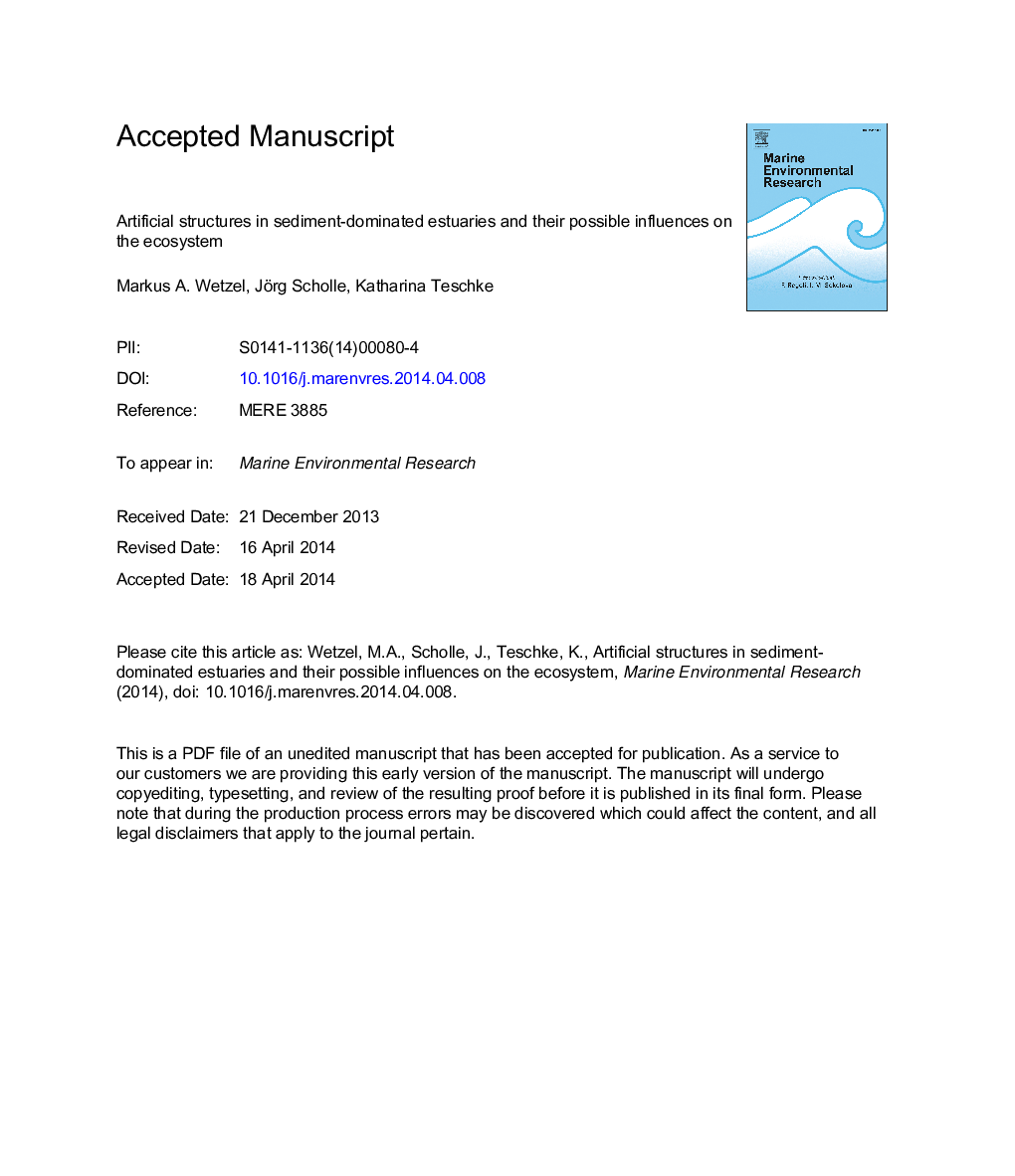| کد مقاله | کد نشریه | سال انتشار | مقاله انگلیسی | نسخه تمام متن |
|---|---|---|---|---|
| 6387813 | 1627583 | 2014 | 56 صفحه PDF | دانلود رایگان |
عنوان انگلیسی مقاله ISI
Artificial structures in sediment-dominated estuaries and their possible influences on the ecosystem
ترجمه فارسی عنوان
سازه های مصنوعی در رودخانه ها تحت تاثیر رسوبات و تاثیرات احتمالی آنها بر اکوسیستم
دانلود مقاله + سفارش ترجمه
دانلود مقاله ISI انگلیسی
رایگان برای ایرانیان
کلمات کلیدی
ترجمه چکیده
بسترهای مصنوعی امروزه در اغلب اقیانوس ها، اغلب در قالب ریز رپ های عظیم مورد استفاده قرار می گیرند. در حوضه وستر آلمان، 60 درصد از خط ساحلی با چنین زیرگونه مصنوعی پوشیده شده است، در حالی که زیره طبیعی سنگی مانند همه دره های دریای واددن وجود ندارد. این مقدار زیادی از زیربناهای مصنوعی ممکن است توسط یک جامعه سفت و سخت سفت و سخت، که از مجموعه محلی نرم نرم بستر متفاوت است، کلنی شود. در این مطالعه، ترکیبات گونه، فراوانی، زیست توده و تعداد گونه های جوامع بتوزی زیر دهاتی را در گونه ها و در زیستگاه طبیعی، رسوب و در شیب شوری غبار وستر مورد بررسی قرار دادیم. ترکیب گونه ها در هر دو زیر اسید به طور معنی داری با شوری تغییر یافت و همچنین بین زیره ها تفاوت معنی داری داشت. در مقایسه با رسوبات، غارها برای خاک های غیر بومی و نه برای گونه های در معرض خطر از لحاظ فراوانی، بیوماس و تعداد گونه ها سود زیادی ندارند، اما نشان دهنده زیستگاه با فراوانی کل و زیست توده هستند؛ هرچند برخی از گونه های غیر بومی حتی به طور انحصاری در حوضچه ها اتفاق می افتد. به طور خاص، گیاهان پشتیبانی از فیلترهای تغذیه ارگانیسم که نقش مهمی را با پیوند شبکه های غذای دریایی و پلاژیکی. تسلط فیدرهای تعلیق بر خدمات اکوسیستم سنگاپور تأثیر می گذارد و ممکن است پیامدهای مهمی برای مدیریت استوایی با تغییر وضعیت کیفیت محیط زیست استوایی داشته باشد. بدین ترتیب، زیر ساخت های مصنوعی باید در برنامه ریزی حفاظت آینده و در نظارت بر کیفیت محیط زیست فون بنتونیتی با توجه به دستورالعمل چارچوب آب در نظر گرفته شود.
موضوعات مرتبط
مهندسی و علوم پایه
علوم زمین و سیارات
اقیانوس شناسی
چکیده انگلیسی
Artificial substrates are omnipresent today in most estuaries mostly in form of massive rip-rap used for groynes and jetties. In the Weser estuary, Germany, 60% of the shoreline is covered with such artificial substrates while, natural rocky substrate is lacking, as in all Wadden Sea estuaries. This large quantity of artificial substrates may be colonized by a benthic hard-substrate community which differs from the local natural soft-substrate assemblage. In this study we examined species compositions, abundances, biomass, and numbers of species of subtidal benthic communities on groynes and in the natural habitat, the sediment, along the salinity gradient of the Weser estuary. Species composition changed on both substrates significantly with salinity and was also significantly different between the substrates. In a comparison with the sediment, the groynes did not provide any benefit for non-indigenous nor for endangered species in terms of abundance, biomass, and number of species, but represent habitats with higher total abundances and biomass; though some non-indigenous species even occurred exclusively on groynes. In particular, groynes supported filter-feeding organisms which play an important role by linking benthic and pelagic food webs. The dominance of the suspension feeders affects crucial estuarine ecosystem services and may have important implications for the estuarine management by altering the estuarine ecological quality status. Hence, artificial substrates should be considered in future conservation planning and in ecological quality monitoring of the benthic fauna according to the European Water Framework Directive.
ناشر
Database: Elsevier - ScienceDirect (ساینس دایرکت)
Journal: Marine Environmental Research - Volume 99, August 2014, Pages 125-135
Journal: Marine Environmental Research - Volume 99, August 2014, Pages 125-135
نویسندگان
Markus A. Wetzel, Jörg Scholle, Katharina Teschke,
